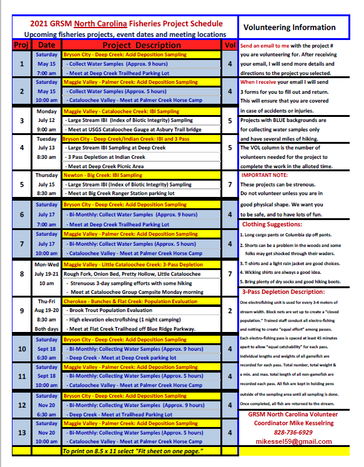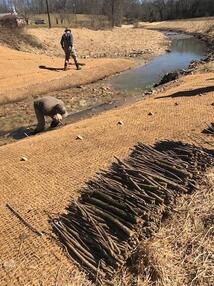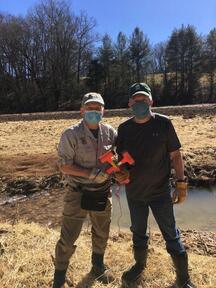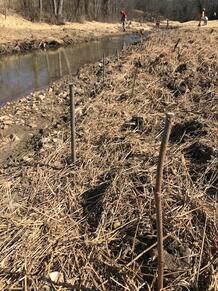Other Great Work Going on in Trout Unlimited
Great Smoky Mountains National Park Fisheries Project
|
Fisheries Projects:
The Great Smoky Mountains National Park Fisheries Department is gearing up for another year of Brook Trout fisheries projects, population evaluations and acid deposition water sample collecting. This email includes information on how to sign up to volunteer. You can access the schedule and how to sign up here. To volunteer for one or more of thirteen projects on the North Carolina side of the GSMNP - 1. Open the attached document and look it over. 2. Follow the instructions on how to sign up shown in the right column. 3. Once you sign up and get on the schedule you will be sent details and maps. 4. You will get an email reminder shortly before your scheduled project dates. 5. A virtual training presentation is scheduled for volunteers described below. Thank you for your interest in volunteering. Sincerely, Mike Kesselring Volunteer Coordinator GSMNP N.C. Fisheries [email protected] 828-736-6929 |
|
Stone Mountain TU plans stream clean
The Stone Mountain Chapter of Trout Unlimited will be conducting a Stream Sweep Saturday, March the 27th. We will meet in the parking lot in front of the Big Lots on 421 in Wilkesboro at 8:00 am, then drive up to Boone to clean trash out of a section of the South Fork of the New River. If you would like to join us or have questions you may respond to this post.
For more information, please follow the Stone Mountain Trout Unlimited Facebook Page.
The Stone Mountain Chapter of Trout Unlimited will be conducting a Stream Sweep Saturday, March the 27th. We will meet in the parking lot in front of the Big Lots on 421 in Wilkesboro at 8:00 am, then drive up to Boone to clean trash out of a section of the South Fork of the New River. If you would like to join us or have questions you may respond to this post.
For more information, please follow the Stone Mountain Trout Unlimited Facebook Page.
Pisgah Chapter of TU work on Foster Creek, tributary of Mills River
On February 23, PIsgah Chapter members worked with our neighboring TU chapter, Land O' Sky, and the Mills River Partnership helping to restore a section of a tributary of the Mills River. This was the second work day that we helped install thousands of plants along the banks of Foster Creek that is undergoing restoration on property owned by the Living Web Farm. The original stream was moved decades ago and the floodplain was developed for agriculture. High banks and channelization caused this section of Foster Creek to become incised. This resulted in high erosion, increasing sedimentation downstream, and poor aquatic habitat.
This restoration project shifted the stream away from North Mills River Road, restored river morphology and function, and reconnected the stream to the floodplain. Short sections of native plants were inserted into the ground using a method known as "live staking". This method takes cuttings from mature plants during the dormant season and allows easy transplanting at a very low cost. You can watch the transformation of this stream as you drive up North Mills River Road about 1.5 miles west of Hwy 191.
On February 23, PIsgah Chapter members worked with our neighboring TU chapter, Land O' Sky, and the Mills River Partnership helping to restore a section of a tributary of the Mills River. This was the second work day that we helped install thousands of plants along the banks of Foster Creek that is undergoing restoration on property owned by the Living Web Farm. The original stream was moved decades ago and the floodplain was developed for agriculture. High banks and channelization caused this section of Foster Creek to become incised. This resulted in high erosion, increasing sedimentation downstream, and poor aquatic habitat.
This restoration project shifted the stream away from North Mills River Road, restored river morphology and function, and reconnected the stream to the floodplain. Short sections of native plants were inserted into the ground using a method known as "live staking". This method takes cuttings from mature plants during the dormant season and allows easy transplanting at a very low cost. You can watch the transformation of this stream as you drive up North Mills River Road about 1.5 miles west of Hwy 191.



